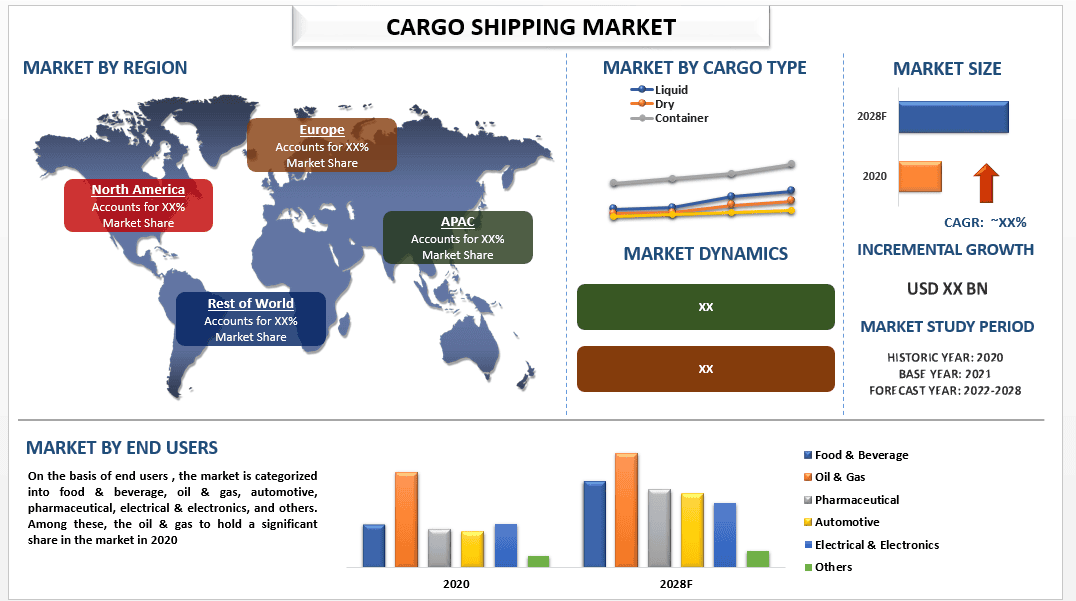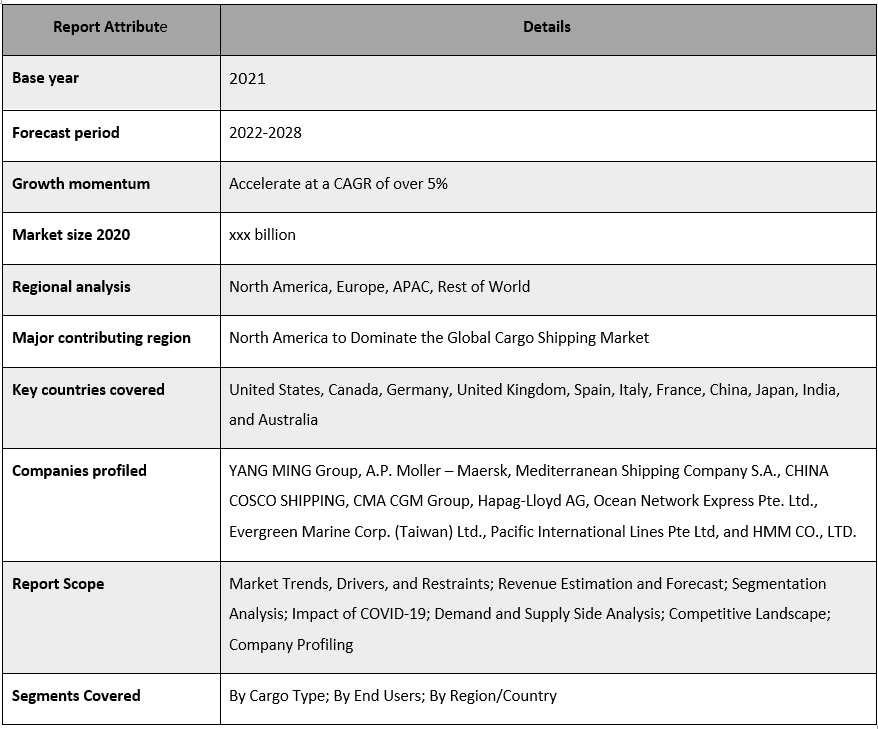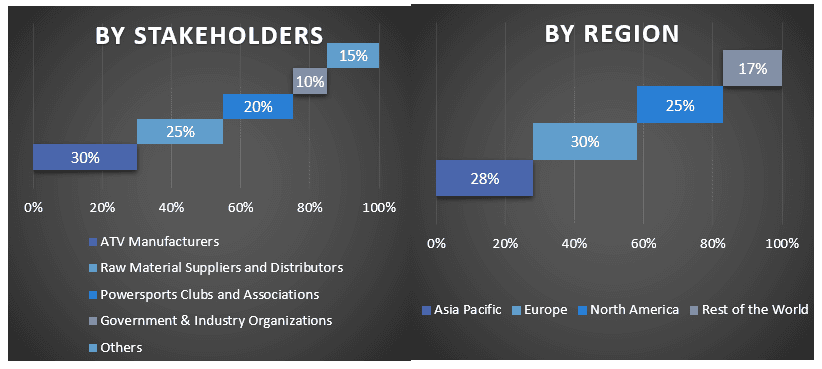- Home
- About Us
- Industry
- Services
- Reading
- Contact Us
Cargo Shipping Market: Current Analysis and Forecast (2022-2028)
Emphasis on Cargo Type (Liquid, Dry, Container And General); End Users (Food & Beverage, Oil & Gas, Automotive, Pharmaceutical, Electrical & Electronics, And Others)); and Region/Country

Global Cargo Shipping Market is expected to grow at a significant rate of around 5% during the forecast period. The global cargo shipping market refers to the movement of goods and products from one place to another using cargo ships. It is a highly competitive industry, with players ranging from large multinational corporations to smaller local operators. The market is influenced by several factors, such as trade policies, economic growth, demand for goods, technological advancements, and fuel prices. The increasing trend of e-commerce has also boosted the demand for cargo shipping services. However, the industry faces challenges such as overcapacity, increased regulation, and environmental concerns. The adoption of digital technologies, such as blockchain and autonomous ships, is expected to bring efficiency and cost savings to the industry in the future. Overall, the global cargo shipping market is expected to grow in the coming years, driven by the continued growth of international trade and the increasing demand for goods and products.
YANG MING Group, A.P. Moller – Maersk, Mediterranean Shipping Company S.A., CHINA COSCO SHIPPING, CMA CGM Group, Hapag-Lloyd AG, Ocean Network Express Pte. Ltd., Evergreen Marine Corp. (Taiwan) Ltd., Pacific International Lines Pte Ltd, and HMM CO., LTD. are some of the key players in the market. Several M&As along with partnerships have been undertaken by these players to facilitate customers with hi-tech and innovative products/technologies.
Insights Presented in the Report
“Amongst cargo type, Dry cargo category to witness higher CAGR during the forecast period”
Based on cargo type, the market is segmented into liquid, dry, container and general. The dry cargo segment witnesses a higher CAGR during the forecast period owing to factors such as increased demand for bulk commodities such as coal, iron ore, and grains. Additionally, Technological advancements in cargo handling and storage have made it easier to transport and store dry cargo, increasing its popularity among shippers. Furthermore, The growth of e-commerce has led to an increased demand for dry cargo shipping, as many online purchases are delivered through dry cargo ships.. These factors have contributed to the increased demand for dry cargo transportation and the corresponding growth of the dry cargo market segment.
“Amongst end users, the automotive segment to witness higher CAGR during the forecast period”
On the basis of end users, the market is categorized into food & beverage, oil & gas, automotive, pharmaceutical, electrical & electronics, and others. Among these, electrical & electronics witness higher CAGR during the forecast period. The E&E industry is continuously evolving, with new technologies being developed and introduced into the market. These advancements are driving the growth of the E&E cargo shipping market. The rapid growth of the e-commerce industry has resulted in a significant increase in the demand for shipping services, as more and more people are purchasing goods online. Additionally, the growth of global trade has led to an increased demand for advanced electronics all over the world. Overall, these factors are contributing to the growth of the E&E market in cargo shipping and are expected to drive further growth in the coming years.
Cargo Shipping Market Report Coverage

“Asia Pacific to hold a significant share in the market.”
As of 2021, the Asia-Pacific region has one of the largest shares in the global cargo shipping market. The Asia-Pacific region has some of the world’s fastest-growing economies, such as China and India, leading to a high demand for goods and increased shipping activity in the region. This region is home to many manufacturing hubs, particularly in countries like China and Japan, which results in a high volume of exports from the region. Additionally, the Asia-Pacific region has the largest population in the world, leading to a high demand for consumer goods and a large domestic market for cargo shipping. Furthermore, many countries in this region are investing in developing their transportation infrastructure, including ports, roads, and railroads, which is boosting the cargo shipping market. These factors have combined to make the Asia-Pacific region the largest market for cargo shipping in the world.
Reasons to buy this report:
- The study includes market sizing and forecasting analysis validated by authenticated key industry experts.
- The report presents a quick review of overall industry performance at one glance.
- The report covers an in-depth analysis of prominent industry peers with a primary focus on key business financials, product portfolio, expansion strategies, and recent developments.
- Detailed examination of drivers, restraints, key trends, and opportunities prevailing in the industry.
- The study comprehensively covers the market across different segments.
- Deep dive regional level analysis of the industry.
Customization Options:
The global cargo shipping market can further be customized as per the requirement or any other market segment. Besides this, UMI understands that you may have your own business needs, hence feel free to connect with us to get a report that completely suits your requirements.
Table of Content
Research Methodology for the Cargo Shipping Market Analysis (2022-2028)
Analyzing the historical market, estimating the current market, and forecasting the future market of the global cargo shipping market were the three major steps undertaken to create and analyze the adoption of cargo shipping in major regions globally. Exhaustive secondary research was conducted to collect the historical market numbers and estimate the current market size. Secondly, to validate these insights, numerous findings and assumptions were taken into consideration. Moreover, exhaustive primary interviews were also conducted, with industry experts across the value chain of the global cargo shipping market. Post assumption and validation of market numbers through primary interviews, we employed a top-down/bottom-up approach to forecasting the complete market size. Thereafter, market breakdown and data triangulation methods were adopted to estimate and analyze the market size of segments and sub-segments of the industry pertains to. Detailed methodology is explained below:
Analysis of Historical Market Size
Step 1: In-Depth Study of Secondary Sources:
Detail secondary study was conducted to obtain the historical market size of the cargo shipping market through company internal sources such as annual reports & financial statements, performance presentations, press releases, etc., and external sources including journals, news & articles, government publications, competitor publications, sector reports, third-party database, and other credible publications.
Step 2: Market Segmentation:
After obtaining the historical market size of the cargo shipping market, we conducted a detailed secondary analysis to gather historical market insights and share for different segments & sub-segments for major regions. Major segments are included in the report as cargo type and end users. Further country-level analyses were conducted to evaluate the overall adoption of testing models in that region.
Step 3: Factor Analysis:
After acquiring the historical market size of different segments and sub-segments, we conducted a detailed factor analysis to estimate the current market size of the cargo shipping market. Further, we conducted factor analysis using dependent and independent variables such as various cargo type and end users of cargo shipping. A thorough analysis was conducted for demand and supply-side scenarios considering top partnerships, mergers and acquisitions, business expansion, and product launches in the cargo shipping market sector across the globe.
Current Market Size Estimate & Forecast
Current Market Sizing: Based on actionable insights from the above 3 steps, we arrived at the current market size, key players in the global cargo shipping market, and market shares of the segments. All the required percentage shares split, and market breakdowns were determined using the above-mentioned secondary approach and were verified through primary interviews.
Estimation & Forecasting: For market estimation and forecast, weights were assigned to different factors including drivers & trends, restraints, and opportunities available for the stakeholders. After analyzing these factors, relevant forecasting techniques i.e., the top-down/bottom-up approach were applied to arrive at the market forecast for 2028 for different segments and sub-segments across the major markets globally. The research methodology adopted to estimate the market size encompasses:
- The industry’s market size, in terms of revenue (USD) and the adoption rate of the cargo shipping market across the major markets domestically
- All percentage shares, splits, and breakdowns of market segments and sub-segments
- Key players in the global cargo shipping market in terms of products offered. Also, the growth strategies adopted by these players to compete in the fast-growing market.
Market Size and Share Validation
Primary Research: In-depth interviews were conducted with the Key Opinion Leaders (KOLs) including Top Level Executives (CXO/VPs, Sales Head, Marketing Head, Operational Head, Regional Head, Country Head, etc.) across major regions. Primary research findings were then summarized, and statistical analysis was performed to prove the stated hypothesis. Inputs from primary research were consolidated with secondary findings, hence turning information into actionable insights.
Split of Primary Participants in Different Regions

Market Engineering
The data triangulation technique was employed to complete the overall market estimation and to arrive at precise statistical numbers for each segment and sub-segment of the global cargo shipping market. Data was split into several segments & sub-segments post studying various parameters and trends in the areas of cargo type and end users in the global cargo shipping market.
The main objective of the Global Cargo Shipping Market Study
The current & future market trends of the global cargo shipping market were pinpointed in the study. Investors can gain strategic insights to base their discretion for investments on the qualitative and quantitative analysis performed in the study. Current and future market trends determined the overall attractiveness of the market at a regional level, providing a platform for the industrial participant to exploit the untapped market to benefit from a first-mover advantage. Other quantitative goals of the studies include:
- Analyze the current and forecast market size of the cargo shipping market in terms of value (USD). Also, analyze the current and forecast market size of different segments and sub-segments.
- Segments in the study include areas of cargo type and end users.
- Define and analysis of the regulatory framework for the cargo shipping
- Analyze the value chain involved with the presence of various intermediaries, along with analyzing customer and competitor behaviors of the industry.
- Analyze the current and forecast market size of the cargo shipping market for the major region.
- Major countries of regions studied in the report include Asia Pacific, Europe, North America, and the Rest of the World.
- Company profiles of the cargo shipping market and the growth strategies adopted by the market players to sustain in the fast-growing market.
- Deep dive regional level analysis of the industry
Related Reports
Customers who bought this item also bought










